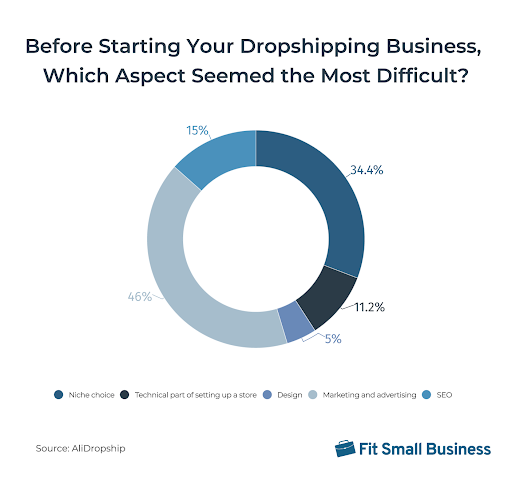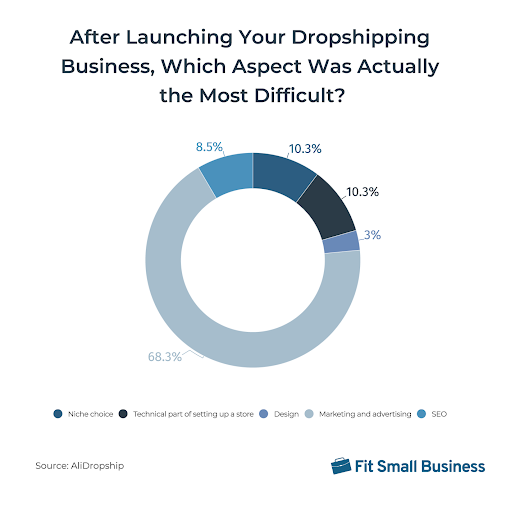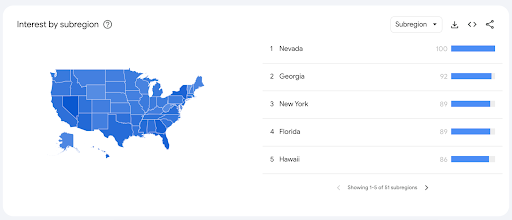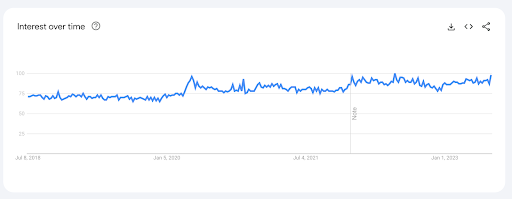Dropshipping is a retail business model where an ecommerce merchant sells physical products without keeping inventory in stock. In this business model, the retailer is the online storefront where customers purchase goods. They then outsource the entire manufacturing and order fulfillment process to a dropshipping supplier.
In this article, we go over key statistics that reflect the dropshipping market size, growth, and trends, as well as a few examples. Read on to learn more.
Key Takeaways:
- Retail and dropshipping trends indicate the market is growing and will continue to do so—globally. It’s a great business opportunity if you can find the right niche.
- Growing popularity also means growing competition. There are more dropshippers than ever before, so it’s important to nail your marketing and customer experience.
- Dropshipping is a flexible business model. You can put as much effort as you want into it, depending on the results you want to achieve.
Dropship Market Stats
1. The global dropshipping market was $225.99 billion in 2022
Forecasts for dropshipping industry statistics predict a compound annual growth rate (CAGR) of 23.5%, resulting in a $1.25 trillion market by 2030. This is largely due to growing consumer preference for online shopping and increasingly easy international commerce.
2. Geographically, APAC is the biggest market
The Asia Pacific region made up nearly 34% of the total market share in 2022, with forecasts to maintain steady growth. Ecommerce in APAC tends to grow more rapidly than in other regions. This growth is also fueled by consumer appetite for small electronics.
3. North America comes in second
North America was the second-largest market, with a forecast 23.5% CAGR through 2030. Dropshipping in the US was an estimated $80.5 billion market in 2022. Artificial intelligence (AI) has been a catalyst for this growth, as merchants have been able to optimize sales and operations.
Get more insights about AI in Retail in our small business guide.

4. China’s dropshipping market is expected to grow at 29.8% CAGR
Dropshipping is huge in the Chinese market. Its forecast growth is nearly a 30% CAGR from 2022 through 2030. This means it’ll be worth some $400 billion by 2030.
5. Dropshipping is growing slowly but steadily in other regions
While other dropshipping markets around the world aren’t experiencing the explosive growth seen in the US and China, they are still making headway. In Canada, the forecast CAGR is 18.8% from 2022 through 2030. For Germany, it is 16.9%, and for Japan, it is 15.2%.
Stats on Dropshipping Platforms & Segments
6. There are 12 top global dropshipping companies
Grand View Research identifies the top 12 players in the dropshipping market as follows:
- Etsy, Inc.
- Alidropship
- Doba Inc.
- Megagoods Inc.
- Inventory Source
- Modalyst Inc.
- Shopify Inc.
- SaleHoo Group Limited
- Sunrise Wholesale Merchandise LLC
- Printify
- Cin7 Orderhive Inc.
- Wholesale2b
7. Shopify dropshipped 1.9 million products in one year
In 2021 alone, Shopify dropshipped 1.9 million products in the Americas, making it the top ecommerce dropshipper that year. Oberlo, in comparison, dropshipped 33,000.
Interested in using Shopify to launch a dropshipping business? Learn how in our guide.
8. There are 6 core dropshipping segments
Grand View Research groups dropshipping into six categories:
- Toys
- Hobby and DIY
- Furniture and appliances
- Food and personal care
- Electronics and media
- Fashion
Of these, products from the fashion segment were the most commonly dropshipped. Fashion is also estimated to attain the highest growth through 2030, with a CAGR of just under 25%. This is due to a rise in consumer preference for branded products and online marketplaces, as well as global social commerce.
Electronics and media accounted for nearly 20% of the dropshipping market share in 2022.
9. Apparel is the top-selling dropshipping category on Shopify
Apparel items accounted for almost 16% of all dropshipped products sold through Shopify from 2017 through April 2021. Other top categories included home and garden, with about 370,000 products, and jewelry and watches, with more than 280,000 products.
Find more interesting shopping trends in our compilation of online shopping statistics.
Dropshipper Insights
10. Marketing is the biggest perceived challenge for 46% of dropshippers

According to a 2020 survey, marketing and advertising is the biggest perceived challenge of running a successful dropshipping business for 46% of respondents. Choosing a niche is another major challenge—the top challenge for 34.4% of respondents. Other perceived challenges are related to the technical requirements of setting up a store, optimizing the store for search, and designing the store, brand, or product.
11. Marketing turned out to be the biggest actual challenge for 68.3% of dropshippers

Once those aspiring dropshippers actually started their business, the perceived challenges were met with reality. Nearly 70% of respondents said marketing and advertising is, in fact, the biggest obstacle. Just 10.3% cited choosing a niche, tying in second with the technical requirements for starting the store. SEO is an actual top challenge for 8.5% of dropshippers, and design came in last again.
Get actionable tips for growing your online business. See our guide to ecommerce marketing strategies.
12. Dropshipping boosts student interest in entrepreneurship by 15%
Dropshipping is an accessible entrepreneurial venture. According to one analysis, it actually inspired entrepreneurship in college students. It concluded that the prospect of running your own dropshipping business via an ecommerce grows student entrepreneurial interest by 15%.
13. 34% of dropshippers engage in environmental, social, and corporate governance
One survey concluded that only about 34% of dropshippers practice environmental, social, and corporate governance (ESG). However, this figure is growing as businesses become more conscious of the impact of their operations.
Dropshipping Channel Stats
14. Nevada is the state with most searches for “dropshipping”
According to Google Trends, searchers in Nevada have the most interest in “dropshipping.” Other top states include Georgia, New York, Florida, and Hawaii.

15. Dropshipping peaked in search 3 times in the past 5 years

According to Google Trends, “dropshipping” searches peaked:
- April 2020: Likely early pandemic interest due to stay-at-home orders
- January 2022: Immediately after an improvement to Google data collection
- June 2022: Reasons unknown
16. Integrating social media with dropshipping can boost sales by 20%
According to one analysis, sales increased by 20% after dropshippers integrated social media with their dropshipping strategy. The study concluded that this was largely due to the fact that social media enabled dropshippers to reach a wider audience and reduce friction in the purchase process.
Learn more about social commerce trends in our article on omnichannel statistics for retailers.
17. Google Ads gets the highest revenue for dropshippers
Dropshippers who advertise on Google Ads rake in the best average monthly revenue at 53.96 euros, or approximately $60.
18. Pinterest gets the lowest revenue for dropshippers
When it comes to social media marketing and advertising, Pinterest delivers some of the least impressive results. Its average monthly revenue is 29.50 euros, which is between $30–$35.
19. The average monthly revenue of all advertising channels is around $43
According to one analysis of dropshippers based in the European Union, the average monthly revenue from online advertising channels is 39 euros, which equates to around $43.
Dropshipping Examples & Case Studies
20. Dogecore processes around 3,000 monthly orders
Dogecore is a dropshipped brand centered around the popularity of an internet meme. Co-founder Dominic Jackson started the brand as a small art project, and it has since grown into a thriving ecommerce company. Dogecore processes more than 3,000 orders a month.
21. Subtle Asian Treats made $19,000 in two months
Subtle Asian Treats is an online brand that sells bubble tea plush toys and similar merchandise. When it launched during the COVID-19 pandemic, the store made $19,000 in profit in just two months.
22. Bootsies Boutique makes $50,000 in sales per year
Bootsies Boutique found its beginning out of necessity. Sisters Carolyn Newsom and Virginia Ehrlich launched their online store to raise money to support their brother’s medical needs—he’s a diabetic and double-leg amputee. What started as a retail project earning just a few hundred dollars turned into a $50,000-a-year business. The two were even able to quit their full-time jobs.
23. Cheery Kid earns $35,000 per month
Cheery Kid is another great real-world example of a successful dropshipping business. The kids’ brand launched in September 2020. Just two months later, it earned $8,128 in just six days. Now, the brand has an average dropshipping income of about $35,000 a month in sales.
24. Itsjusta6 gets 6,000+ monthly orders
Itsjusta6 is a brand in the automotive industry that started out small but has amassed 1.2 million YouTube subscribers and 600,0000 followers on Facebook and Instagram combined. After building a loyal audience, Itsjusta6 launched its clothing brand. The dropshipped items drive 6,000–7,000 orders every month—about $250,000–$300,000 in monthly revenue.
25. Ethan Dobbins made $280,000 in sales in one year
Dropshipping entrepreneur Ethan Dobbins got his start at just 16 years old. His first attempt failed, but that didn’t deter him. He gave dropshipping another go and made $280,000 in revenue, making a profit of $80,000–$90,000. His takeaways? Get the logistics right, pick the right trending dropshipping products, run paid ads strategically, and know when to cut your losses.
26. Inspire Uplift sees 15,000 monthly orders
Inspire Uplift is a dropshipping store that processes an average of 500 orders a day—or 15,000 orders a month. During the holiday season, it can get as much as 2,000–3,000 orders a day.
27. One dropshipper made $6,667 in less than 8 weeks with 3 dropshipped products
Tim Kock tapped into ecommerce and pop culture trends by creating a dropshipping store that quickly earned him a lot of sales. He sold a pineapple necklace, a watch, and a pineapple hat to thousands of customers, earning nearly $7,000 in less than two months.
What Dropshipping Statistics Mean for Small Businesses
What does this dropshipping data mean for your small business? Our small business experts offer this advice:
- Nail your branding and marketing: Differentiation is key to standing out in a crowded market. Lean into corporate social responsibility when possible, and create a strong brand with an equally impressive customer experience. Dropshippers that put the customer experience first will have an easier time of beating out the competition.
- Choose your niche wisely: Conduct plenty of market research to validate your business and product ideas. This includes looking at the dropshipping statistics listed above as well as other analyses—competitive analysis, SWOT analysis, focus groups, surveys, and more.
- Go global: Ecommerce has allowed entrepreneurs to sell to people all over the world—not just shoppers in their local markets. International commerce continues to grow, and with dropshipping market growth all over the world, it’s never been a better time to tap into cross-border commerce.
Dropshipping Statistics Frequently Asked Questions (FAQs)
Here are some of the most common questions and statistics around dropshipping, according to Printful and Cloudways:
About 30% of online businesses use dropshipping.
90% of dropshippers fail. Many of these failures happen soon after launching due to selecting the wrong niche, not making the proper time or resourcing investments, and lacking patience. With careful planning and realistic expectations, it is possible to have a successful dropshipping business.
10% of dropshippers succeed.
Dropshipping makes up about 30% of online businesses.
Bottom Line
Dropshipping statistics show that this business opportunity continues to grow in popularity even well past the COVID-19 pandemic. Dropshipping entrepreneurs are challenged with marketing, advertising, SEO, and choosing the right niche. And customers are overall pleased but always looking for improved experiences.
With these dropshipping trends and statistics, you have a better understanding of this ecommerce opportunity. If you think you’re ready to invest in dropshipping yourself, learn more about what dropshipping is and how to start a dropshipping business of your own.